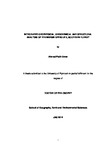INTEGRATED GEOPHYSICAL, GEOCHEMICAL AND STRUCTURAL ANALYSIS OF THE MERSIN OPHIOLITE, SOUTHERN TURKEY
| dc.contributor.supervisor | MORRIS, ANTONY | |
| dc.contributor.author | OMER, AHMED FATIH | |
| dc.contributor.other | School of Geography, Earth and Environmental Sciences | en_US |
| dc.date.accessioned | 2014-09-09T12:05:10Z | |
| dc.date.available | 2014-09-09T12:05:10Z | |
| dc.date.issued | 2014 | |
| dc.date.issued | 2014 | |
| dc.identifier | 10228319 | en_US |
| dc.identifier.uri | http://hdl.handle.net/10026.1/3101 | |
| dc.description.abstract |
This study examines the tectonic evolution of the Mersin ophiolite of the central Tauride of Turkey, using palaeomagnetic, structural and geochemical analyses. This ophiolite represents one of the best examples of Tethyan-type ophiolites formed by supra-subduction zone spreading within the northern Neotethyan Ocean basin during the Late Cretaceous. It exposes a 3.0 km section of lower crustal, cumulate rocks, and tectonically separated exposures of the underlying mantle sequence and metamorphic sole, both of which are cut by basaltic dykes. Stepwise thermal and alternating field demagnetization of ultramafic and gabbroic cumulates from 18 sites mostly identified single components of remanent magnetization characterized by ENE-directed, moderately upwards inclined directions in geographic coordinates with high coercivities/high unblocking temperatures. The slight increase in scattering in remanence directions after tilt correction has been interpreted to be related to local variations in orientation of cumulates layering within the magma chamber. Rock magnetic investigations showed that magnetite is the main magnetic mineral in the majority of ultramafic, gabbro and dyke rock samples, and rock magnetic and demagnetization characteristics suggest that the samples carry thermoremanent magnetizations acquired during crustal accretion. Net tectonic rotation analyses show that all the units of the Mersin ophiolite, including lower crustal cumulates, dykes in the mantle sequence and dykes in the metamorphic sole have experienced large clockwise rotations around NE- trending, moderately plunging to sub-horizontal axes. Correcting anisotropy of magnetic susceptibility data for the effects of these rotations suggests that magmatic flow in the cumulates had an initial NNE-SSW orientation, which if assumed to relate to seafloor spreading suggests that the Mersin spreading axis was oriented WNW-ESE. This is consistent with regional palaeogeographic reconstructions. The net tectonic rotation data show that dykes in the metamorphic sole are rotated by c. 45°, significantly less than the c. 115° rotations seen in the mantle sequence and in the cumulate sequences of the overlying thrust sheets. These results therefore document an initial stage of intra-oceanic clockwise rotation of the ophiolite that occurred after initial detachment but prior to emplacement of dykes cutting the metamorphic sole. Subsequent additional clockwise rotation (of all units) may be attributed to further intra-oceanic rotation (preferred interpretation) or to later emplacement of the ophiolite onto the Tauride continental margin. Finally, some new, preliminary data are presented from the Lizard ophiolite of Cornwall in Appendix A, forming the results of a training project undertaken while awaiting permission for fieldwork in Turkey. | en_US |
| dc.description.sponsorship | Ministry of Higher Education and Scientific Research-Iraq | en_US |
| dc.language.iso | en | en_US |
| dc.publisher | Plymouth University | en_US |
| dc.subject | Mersin | |
| dc.subject | Palaeomagnetism | |
| dc.subject | Suprasubduction | |
| dc.subject | Ophiolite | en_US |
| dc.title | INTEGRATED GEOPHYSICAL, GEOCHEMICAL AND STRUCTURAL ANALYSIS OF THE MERSIN OPHIOLITE, SOUTHERN TURKEY | en_US |
| dc.type | Thesis | |
| plymouth.version | Full version | en_US |
| dc.identifier.doi | http://dx.doi.org/10.24382/4816 |
Files in this item
This item appears in the following Collection(s)
-
01 Research Theses Main Collection
Research Theses Main


